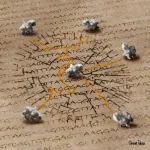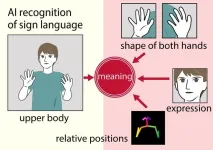(Press-News.org) The three-dimensional shape of a protein can be used to resolve deep, ancient evolutionary relationships in the tree of life, according to a study in Nature Communications.
It is the first time researchers use data from protein shapes and combine it with data from genomic sequences to improve the reliability of evolutionary trees, a critical resource used by the scientific community for understanding the history of life, monitor the spread of pathogens or create new treatments for disease.
Crucially, the approach works even with the predicted structures of proteins that have never been experimentally determined. It has implications for the massive amount of structural data being generated by tools like AlphaFold 2 and help open new windows into the ancient history of life on Earth.
There are 210 thousand experimentally determined protein structures but 250 million known protein sequences. Initiatives like the EarthBioGenome project could generate billions more protein sequences in the next few years. The abundance of data opens the door to applying the approach on an unprecedented scale.
For many decades, biologists have been reconstructing evolution by tracing how species and genes diverge from common ancestors. These phylogenetic or evolutionary trees are traditionally built by comparing DNA or protein sequences and counting the similarities and differences to infer relationships.
However, researchers face a significant hurdle – a problem known as saturation. Over vast timescales, genomic sequences can change so much that they no longer resemble their ancestral forms, erasing signals of shared heritage.
“The issue of saturation dominates phylogeny and represents the main obstacle for the reconstruction of ancient relationships,” says Dr. Cedric Notredame, researcher at the Centre for Genomic Regulation (CRG) and lead author of the study. “It’s like the erosion of an ancient text. The letters become indistinct, and the message is lost.”
To overcome this challenge, the research team turned to the physical structures of proteins. Proteins fold into complex shapes that determine a cell’s function. These shapes are more conserved over evolutionary time than the sequences themselves, meaning they change more slowly and retain ancestral features for longer.
The shape of a protein is dictated by its amino acid sequence. While sequences may mutate, the overall structure often remains similar to preserve function. The researchers hypothesised they could gauge how much the structures diverge over time by measuring the distance between pairs of amino acids within a protein, also known as intra-molecular distances (IMDs).
The study compiled a massive dataset of proteins with known structures, covering a wide range of species. They calculated the IMDs for each protein and used these measurements to construct phylogenetic trees.
They found that trees built from structural data closely matched those derived from genetic sequences, but with a crucial advantage: the structural trees were less affected by saturation. This means they retained reliable signals even when genetic sequences had diverged significantly.
Recognising that both sequences and structures offer valuable insights, the team developed a combined approach which not only improved the reliability of the tree branches but also helped distinguish between correct and incorrect relationships.
"It's akin to having two witnesses describe an event from different angles," explains Dr. Leila Mansouri, coauthor of the study. "Each provides unique details, but together they give a fuller, more accurate account."
One practical example where the combined approach could make a significant impact is in understanding the relationships among kinases in the human genome. Kinases are proteins involved in many different important cellular functions.
"The genome of most mammals, including humans, contains about 500 protein kinases that regulate most aspects of our biology," says Dr. Notredame. "These kinases are major targets for cancer therapy, for example drugs like imatinib for humans or toceranib for dogs."
Human kinases have arisen through duplications occurring over the last billion years. "Within the human genome, the most distantly related kinases are about a billion years apart," says Dr. Notredame. "They duplicated in the common ancestor of the common ancestor of our common ancestor."
This vast timescale involved makes it incredibly difficult to build accurate gene trees that show how all these kinases are related. "Yet, as imperfect as it may be, the kinase evolutionary tree is widely used to understand how it interacts with other drugs. Improving this tree, or improving trees of other important protein families, would be an important advance for human health,” adds Dr. Notredame.
The potential applications of the work go beyond cancer. Using the approach to create more accurate evolutionary trees could also improve our understanding of how diseases evolve more generally, aiding in the development of vaccines and treatments. They can also help shed light on the origins of complex traits, guide the discovery of new enzymes for biotechnology, and even help trace the spread of species in response to climate change.
END
Protein shapes can help untangle life’s ancient history
A new way of merging genomic and structural data can help dive deep into evolutionary relationships
2025-01-15
ELSE PRESS RELEASES FROM THIS DATE:
Memory systems in the brain drive food cravings that could influence body weight
2025-01-15
PHILADELPHIA, PA (January 15, 2025) - Can memory influence what and how much we eat? A groundbreaking Monell Chemical Senses Center study, which links food memory to overeating, answered that question with a resounding “Yes.” Led by Monell Associate Member Guillaume de Lartigue, PhD, the research team identified, for the first time, the brain’s food-specific memory system and its direct role in overeating and diet-induced obesity.
Published in Nature Metabolism, they describe a specific population of neurons in the mouse brain that encode memories for sugar and fat, profoundly impacting food intake and body ...
Indigenous students face cumbersome barriers to attaining post-secondary education
2025-01-15
Indigenous students identified inadequate funding as a major barrier to completing post-secondary education according to a new study published in AlterNative: An International Journal of Indigenous Peoples.
The study surveyed Indigenous university students at Algoma University. The students, who identified as either First Nations or Métis, reported that they required multiple sources of funding, including government student loans and personal savings, to afford their post-secondary education. About two-thirds (69%) of students received funding for their education from First Nations sources, including funding from federal programs for Indigenous students.
“This ...
Not all Hot Jupiters orbit solo
2025-01-15
Hot Jupiters are giant planets initially known to orbit alone close to their star. During their migration towards their star, these planets were thought to accrete or eject any other planets present. However, this paradigm has been overturned by recent observations, and the final blow could come from a new study led by the University of Geneva (UNIGE). A team including the National Centre of Competence in Research (NCCR) PlanetS, the Universities of Bern (UNIBE) and Zurich (UZH) and several foreign universities has just announced the existence of a planetary system, WASP-132, ...
Study shows connection between childhood maltreatment and disease in later life
2025-01-15
University of Birmingham venture Dexter has demonstrated the power of its Dexter software platform in a study showing that people whose childhoods featured abuse, neglect or domestic abuse carry a significantly increased risk of developing rheumatoid arthritis or psoriasis in later life.
The starting point for the recently published study was a database of over 16 million Electronic Health Records, from which the Dexter software defined a cohort, one arm that was exposed to childhood maltreatment, and one arm that was not.
The software then checked the records over a 26-year period ...
Discovery of two planets sheds new light on the formation of planetary systems
2025-01-15
The discovery of two new planets beyond our solar system by a team of astronomers from The University of Warwick and the University of Geneva (UNIGE), is challenging scientific understanding of how planetary systems form.
The existence of these two exoplanets - an inner super-Earth and an outer icy giant planet - within the WASP-132 system is overturning accepted paradigms of how ‘hot Jupiter’ planetary systems form and evolve.
Hot Jupiters are planets with masses similar to those of Jupiter, but which orbit closer to their star than Mercury orbits the Sun. There is not enough gas and dust for these giant planets to form ...
New West Health-Gallup survey finds incoming Trump administration faces high public skepticism over plans to lower healthcare costs
2025-01-15
WASHINGTON, D.C. — Weddnesday, Jan. 15, 2025 — Nearly half of Americans (46%) think the country is headed in the wrong direction when it comes to the incoming president’s policies to lower healthcare costs, while 31% say it’s on the right track, according to the latest West Health-Gallup survey released today.
When viewed through a political lens, only Republicans are more positive than negative about the future of healthcare costs under the Trump administration; nearly three-quarters (73%) think the incoming administration’s healthcare policies are headed in the right direction. In contrast, 24% of independents and 3% of Democrats say the same. Democrats ...
Reading signs: New method improves AI translation of sign language
2025-01-15
Sign languages have been developed by nations around the world to fit the local communication style, and each language consists of thousands of signs. This has made sign languages difficult to learn and understand. Using artificial intelligence to automatically translate the signs into words, known as word-level sign language recognition, has now gained a boost in accuracy through the work of an Osaka Metropolitan University-led research group.
Previous research methods have been focused on capturing information about the signer’s ...
Over 97 million US residents exposed to unregulated contaminants in their drinking water
2025-01-15
Nearly a third of people in the U.S. have been exposed to unregulated contaminants in their drinking water that could impact their health, according to a new analysis by scientists at Silent Spring Institute. What’s more, Hispanic and Black residents are more likely than other groups to have unsafe levels of contaminants in their drinking water and are more likely to live near pollution sources.
The findings, published in the journal Environmental Health Perspectives, add to growing concern about the quality of drinking water in the United States and the disproportionate impact of contamination ...
New large-scale study suggests no link between common brain malignancy and hormone therapy
2025-01-15
CLEVELAND, Ohio (Jan 15, 2025)–It’s not easy being a woman. Just look at the statistics. Women are more likely to have such debilitating conditions as osteoporosis, migraines, Alzheimer disease, depression, multiple sclerosis, and brain tumors. Sex hormones are often blamed. However, a new study suggests no link between hormone therapy (HT) and common brain tumors known as gliomas. Results of the study are published online today in Menopause, the journal of The Menopause Society.
The debate over the risks and benefits ...
AI helps to identify subjective cognitive decline during the menopause transition
2025-01-15
CLEVELAND, Ohio (Jan 15, 2025)—Artificial intelligence (AI) is positioned to make a major impact on almost every industry, including healthcare. A new study suggests that machine learning models can more quickly and affordably identify women with severe subjective cognitive decline during the menopause transition, effectively opening the door to better management of cognitive health. Results of the study are published online today in Menopause, the journal of The Menopause Society.
Subjective cognitive decline refers to a person’s ...
LAST 30 PRESS RELEASES:
Sports injuries sustained during your period might be more severe
World's first successful 2 Tbit/s free-space optical communication using small optical terminals mountable on satellites and HAPS
Can intimate relationships affect your heart? New study says ‘yes’
Scalable and healable gradient textiles for multi‑scenario radiative cooling via bicomponent blow spinning
Research shows informed traders never let a good climate crisis go to waste
Intelligent XGBoost framework enhances asphalt pavement skid resistance assessment
Dual-function biomaterials for postoperative osteosarcoma: Tumor suppression and bone regeneration
New framework reveals where transport emissions concentrate in Singapore
NTP-enhanced lattice oxygen activation in Ce-Co catalysts for low-temperature soot combustion
Synergistic interface engineering in Cu-Zn-Ce catalysts for efficient CO2 hydrogenation to methanol
COVID-19 leaves a lasting mark on the human brain
Scientists use ultrasound to soften and treat cancer tumors without damaging healthy tissue
Community swimming program for Black youth boosts skills, sense of belonging, study finds
Specific depressive symptoms in midlife linked to increased dementia risk
An ‘illuminating’ design sheds light on cholesterol
Who is more likely to get long COVID?
Study showcases resilience and rapid growth of “living rocks”
Naval Research Lab diver earns Office of Naval Research 2025 Sailor of the Year
New Mayo-led study establishes practical definition for rapidly progressive dementia
Fossil fuel industry’s “climate false solutions” reinforce its power and aggravate environmental injustice
Researchers reveal bias in a widely used measure of algorithm performance
Alcohol causes cancer. A study from IOCB Prague confirms damage to DNA and shows how cells defend against it
Hidden viruses in wastewater treatment may shape public health risks, study finds
Unlock the power of nature: how biomass can transform climate mitigation
Biochar reshapes hidden soil microbes that capture carbon dioxide in farmland
Reducing saturated fat intake shows mortality benefit, but only in high-risk individuals
Manta rays create mobile ecosystems, study finds
Study: Mixed results in using lipoic acid to treat progressive multiple sclerosis
Norbert Holtkamp appointed director of Fermi National Accelerator Laboratory
New agentic AI platform accelerates advanced optics design
[Press-News.org] Protein shapes can help untangle life’s ancient historyA new way of merging genomic and structural data can help dive deep into evolutionary relationships




